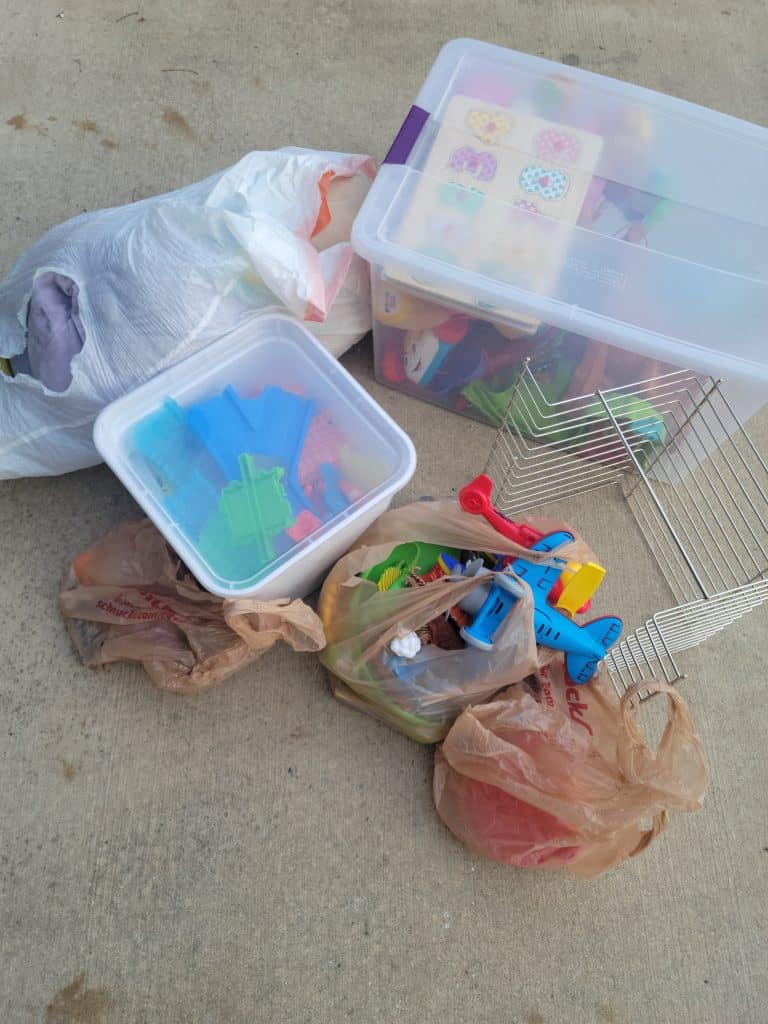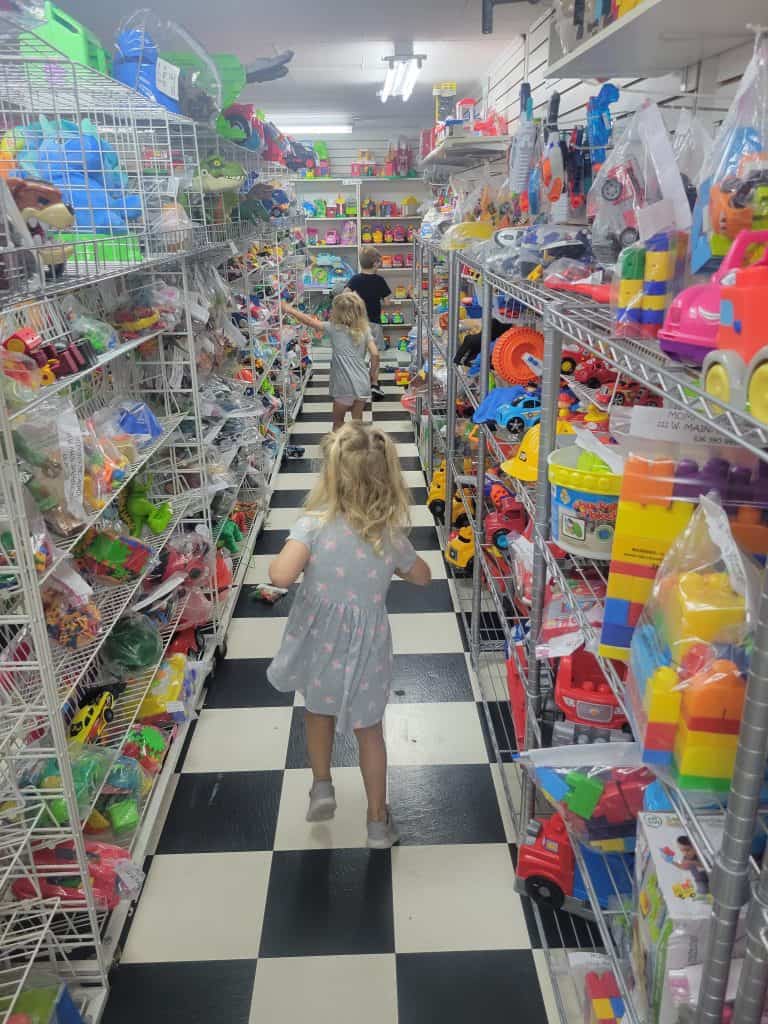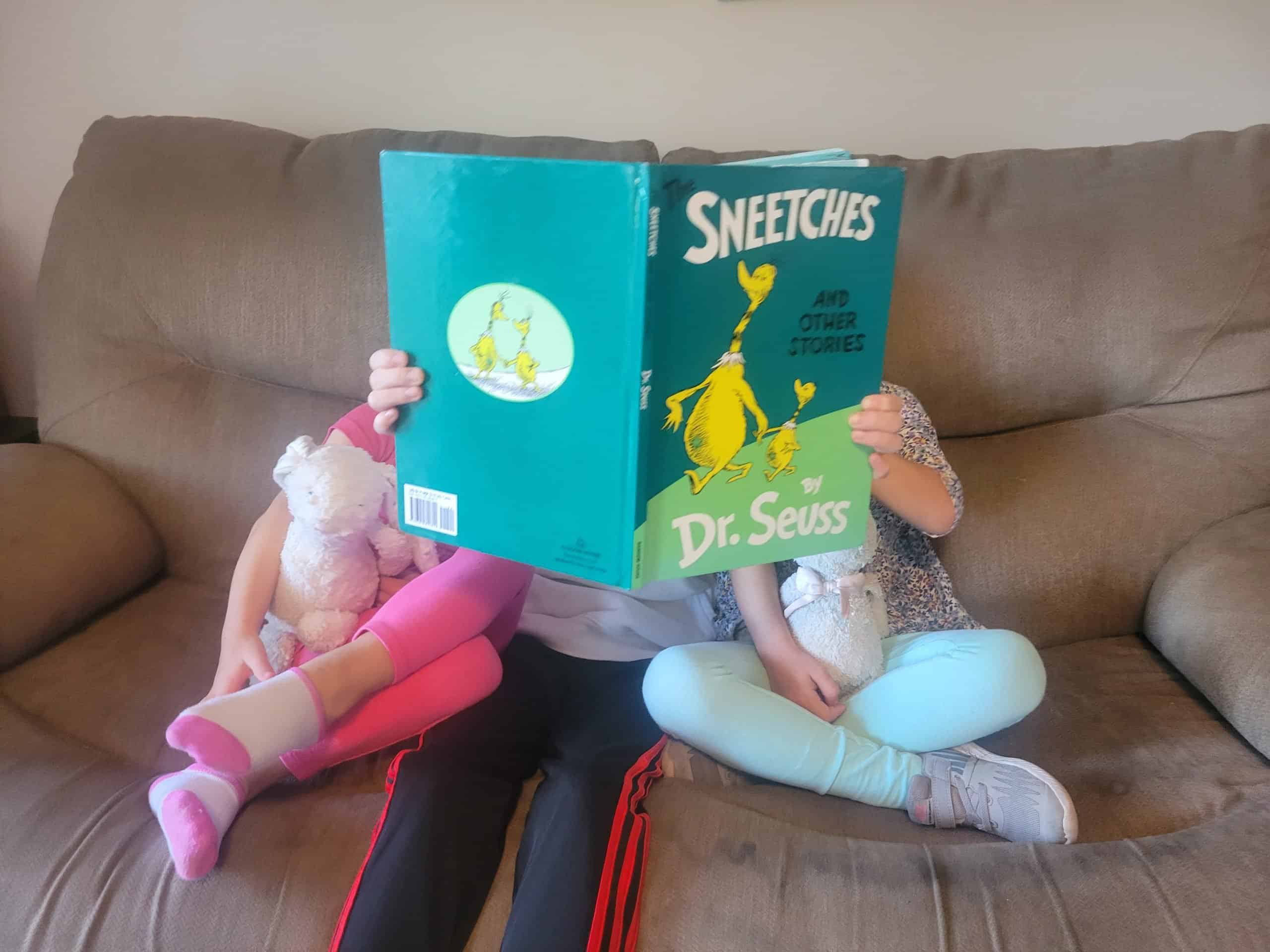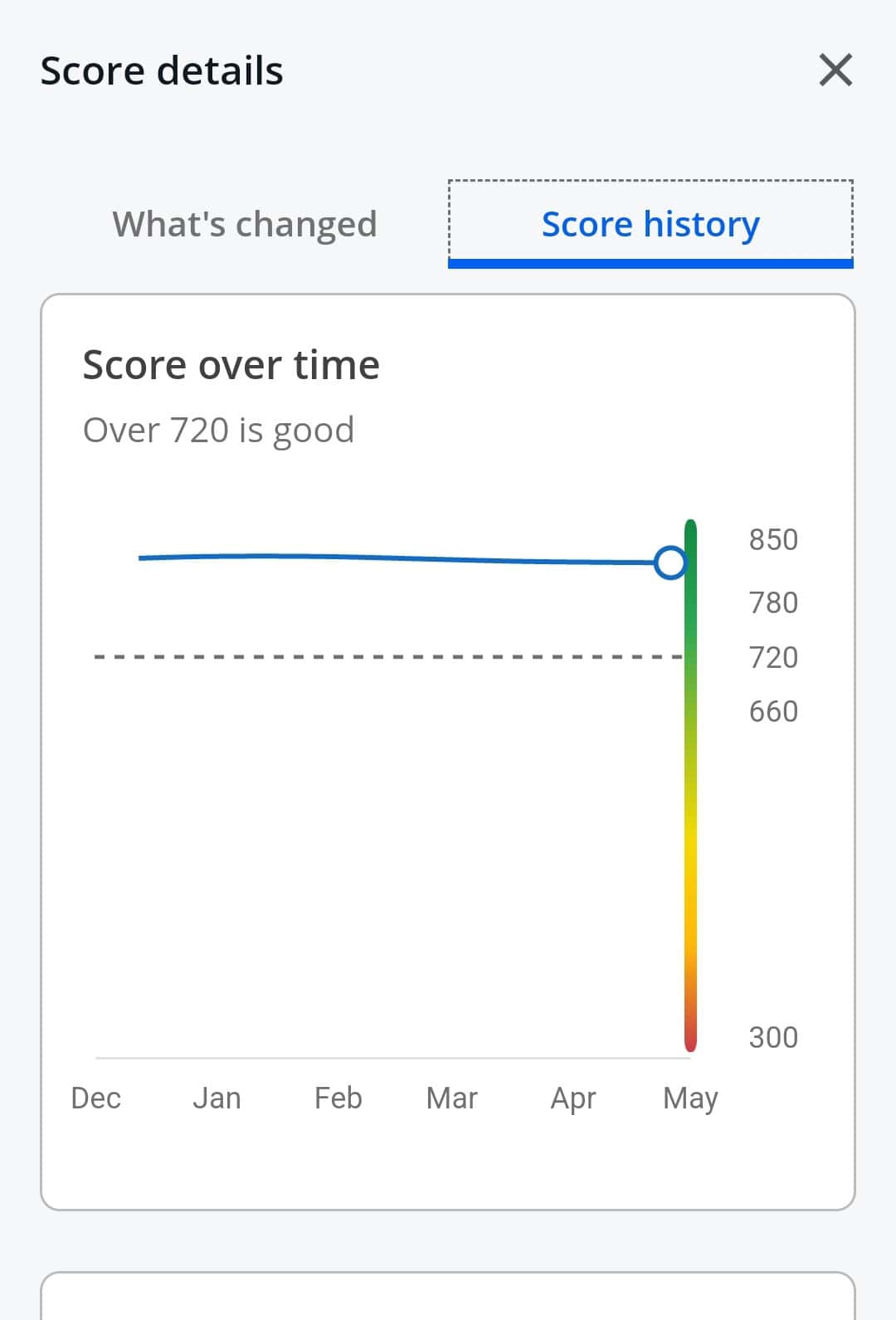How I Teach Kids About Money By Getting Rid Of Their Stuff
As parents, we’ve all encountered the seemingly inexhaustible supply of toys, gadgets, and general kid stuff that seems to multiply in our homes.
If you’re anything like me, you’ve probably looked around your house and wondered how you ended up with so much…stuff.
But here’s the thing: this clutter, while visually overwhelming, presents an unexpected opportunity to be a great dad (and mom)
How, you ask? By using it as a tool to teach kids about money and much more.
In this article, I am going to share my strategy, which I fondly call “Trading Clutter for Cash”.
It’s my way of teaching kids by inspiring them to want to get rid of their stuff. Here’s my process:
Table of Contents
Decluttering Exercise: A Lesson in Communication, Value, and Letting Go
The process starts with a decluttering exercise.
First, I have my three kids, identical four-year-old twins, and their older six-year-old make piles of the items they want to sell. They focus on any toys they no longer play with.
The six-year-old is starting to catch on to which toys will get him more money.
We then sit in a circle, holding up each item one by one, while the other two give a thumbs up or thumbs down on whether they’re willing to part with it.

This method not only minimizes squabbles (and trust me, with three kids under seven, there are plenty of those), but it also helps them understand the concept of consensus and negotiation.
Plus, it ensures that no one’s favorite car gets sold out from under them. It’s a wonderful exercise in communication, value, and letting go.
But that’s just the start. Next we need to do something with the piles.

The Expedition: A Practical Lesson in Economics
Once we’ve sorted through the clutter, we load up the car and head to a secondhand children’s store about an hour away.
Why so far, you ask? Well, turning it into a bit of an expedition adds to the excitement. It turns the transaction into an event.
Upon reaching the store, each child sells their bag of items, receiving in return a budget for new-to-them treasures.
This is where the magic happens. The kids learn first-hand about the value of their old toys and how that translates into purchasing power for new ones.
They also need to sit patiently while their items are being priced. While the assessment is happening I walk the kids through my favorite topics of budgeting and value.
Read that again. This works so well that three kids aged 6 and under sit patiently and wait in a toy store!
They start to understand that better quality items fetch higher prices, incentivizing them to take care of their belongings.
The Spending Spree: Out With The Old, In With The New
Once we know each kid’s budget, I explain to them how much they have to spend. Then they hunt down items they can afford. As they find items I help them with the math.
It’s tough for me. I want to let them go over budget. But I don’t. Ever.
They then buy their new toys, and we head home. Lately I take them to a nearby park on the river to let them play with their new toys, and give me a chance to unwind.
It’s always so rewarding to me to see how few toys they walk away with, compared to how many toys they brought in.
Obviously the toy store likes this as well. They buy our stuff, then sell it for twice as much and give us credit to buy more stuff that other people sold them.

The Learning Curve: Unpacking the Lessons
So, we’ve talked about the journey, the process, and the outcome. But what are the real takeaways here?
What nuggets of wisdom are teaching our kids in this exercise in economics? Let’s unpack that.
Financial Literacy: More Than Just Dollars and Cents
First and foremost, they’re learning about money. Not just the physical coins and bills, but the concept of value.
They’re seeing firsthand how their old, neglected toys can transform into shiny new treasures or even cold, hard cash.
It’s not about making them into little Warren Buffets, but teaching them to respect and understand money.
The Value Lesson: Beyond Price Tags
Now, let’s talk about value. And I don’t mean the kind you find on a price tag. This whole clutter-to-cash business teaches our little ones something about the worth of their possessions.
Kids often have a rather skewed perception of value. To them, a shiny new toy car might seem worth its weight in gold, while an old, dog-eared book is just a dusty relic.
But through this exercise, they start to understand that value isn’t just about shininess or novelty. It’s about usefulness, quality, and demand.
Take that teddy bear, for instance. Perhaps it’s seen better days. Its fur is matted, its button eyes hanging by a thread. But to another child, that bear could be a beloved companion, a source of comfort.
And to the secondhand store, it’s a valuable product. It’s not about what something costs, but what someone is willing to pay for it. A lesson, I might add, that some adults could do well to remember as well.
The Math Class: Who Knew Decluttering Could Be So Educational?
And then, there’s math. Ah, yes, the dreaded M-word. This is math in its most practical, accessible form. No complex equations or confusing formulas, just simple addition, subtraction, and maybe a bit of multiplication and division.
Here’s how it works. Say your child sells five toys for $2 each. That’s $10 in their pocket. Now, they want to buy a new toy for $15. They quickly realize they’re $5 short. So, they need to sell more toys or choose a cheaper one.
It’s basic arithmetic, sure, but it’s also a lesson in budgeting and financial planning.
And for the older kids, there’s even a taste of percentages and profit margins. If the store sells their toys for twice the price, that’s a 100% markup.
And if they want to save up for a $50 video game, they need to set aside a certain percentage of their earnings each week. It’s math in action, math with a purpose. And who knows, it might just make that next math test a little less daunting.
So, there you have it. A decluttering exercise that’s also a crash course in value assessment and practical math. Not too shabby, eh? And to think, all this time, you thought cleaning up was just about, well, cleaning up.
Little did we know, it was an opportunity to mold our kids into savvy little economists. Now, if only we could get them to do the dishes…
Negotiation Skills: The Art of the Deal
Who knew that bargaining over the fate of a teddy bear could teach such valuable skills? Through our decluttering exercise, the kids learn to negotiate.
They learn the art of persuasion, the importance of compromise, and the satisfaction of reaching an agreement. I believe strongly that these skills will serve them well in life, whether they’re haggling at a flea market or navigating a business deal.
Budgeting Basics: The Lemonade Stand Meets Wall Street
Ah, budgeting. It’s the financial equivalent of eating your vegetables. We all know it’s good for us, but it’s not exactly a barrel of laughs.
But here’s the thing – this clutter-to-cash operation we’ve got going on is actually a fun and practical way to introduce your kids to the concept of budgeting.
Here’s how it breaks down. Your kids have a certain amount of cash from their sold toys. They’re eyeing a shiny new toy that costs more than they have.
Instead of reaching into the parental piggy bank, they have to figure out how to make their money stretch. Maybe they sell more toys, or perhaps they negotiate a lower price. Either way, they’re making a budget, even if they don’t realize it.
They’re learning that money is a finite resource, and they have to allocate it wisely. Who knows, maybe they’ll even start to appreciate why you can’t always buy them stuff. Hey, a parent can dream, right?
The Art of Sacrifice: Because You Can’t Always Get What You Want
Now, onto a slightly heavier topic – sacrifice. And our little decluttering venture provides a perfect opportunity to teach it.
You see, when your kids sell their toys, they’re making a sacrifice. They’re giving up something they once loved in exchange for something else – money, in this case.
And when they can’t afford that new toy they’ve been coveting, they learn that they can’t have everything they want.
That they sometimes have to make tough choices, to prioritize. It’s like a microcosm of life, if you will.
Decision-Making: To Keep or Not To Keep
The decluttering process also hones their decision-making skills. They learn to evaluate what’s truly important to them and what can be let go. They learn to “satisfice,” finding a satisfactory solution rather than an optimal one.
It’s a lesson in prioritizing, in making tough choices. And yes, there might be a few tears along the way, but trust me, it’s worth it.
Delayed Gratification: The Marshmallow Test in Action
Remember the famous Stanford marshmallow experiment? Well, this is it in real life. The kids learn to delay gratification.
They learn that by selling their old toys, they can buy something better later on. It’s a lesson in patience, in holding out for a greater reward. And it’s a lesson that will help them resist impulse buys and save money in the future.
Entrepreneurship: The Spark of Business
Lastly, and perhaps most excitingly, they might just catch the entrepreneurship bug. They get a taste of what it’s like to run a business, from sourcing products (in this case, toys) to selling them for a profit. Who knows?
This could be the start of their entrepreneurial journey. After all, many great businesspeople started young.
The Business Model: A Glimpse Into Profit Making
Here’s the kicker, the store sells the items for twice what they paid us for them. It’s a brilliant business model, but it also serves as a practical lesson for the kids on how businesses operate and make a profit.
The children get to see the entire cycle of buying and selling, providing them with a firsthand understanding of the basic principles of economics and commerce.
The Market for Kids’ Items: A Mini Research
So what does used kids’ stuff sell for? We’ve researched that for you.
Obviously prices can vary widely depending on brand, condition, and demand. But here are some general estimates:
- Books: Used children’s books might sell for between $1 and $5 each.
- Clothing: Gently used clothes can range from $2 to $10 per piece, with brand-name items potentially fetching more.
- Toys: Prices for toys can vary greatly. For example, small Lego sets might sell for $10, while larger or rare sets could fetch $50 or more.
- Board Games: A popular board game in good condition can sell for around $5 to $15.
- Puzzles: Depending on the size and complexity, puzzles could earn you anywhere from $1 to $10.
- DVDs: Kids’ movies or series DVDs can fetch anywhere from $1 to $5 per disc.
- Video Games: Depending on the platform and popularity, video games can sell for $5 to $20.
- Bikes: A used kid’s bike in good condition could fetch anywhere from $20 to $100.
- Sporting Equipment: Things like baseball gloves, soccer balls, or roller skates can range from $5 to $50.
- Musical Instruments: A used kid’s guitar could sell for $25, while a keyboard could fetch up to $50 or more.
These are just estimates, and prices can fluctuate based on many factors. However, they provide a general idea of what your kids might expect to earn from their sales.
The Aftermath: Celebrating Success and New Treasures
Once the deals are done and the new treasures selected, sometimes we’ll celebrate with ice cream from the shop next door. But more often than not, they’re so engrossed in their new finds that they forget all about the promise of sugary treats.

The Impact: Financial Literacy and Negotiation Skills
This strategy has proven invaluable in our house, not just for decluttering, but for instilling financial literacy and negotiation skills in the kids at a young age.
Plus, it offers a tangible demonstration of the economic principle of supply and demand.
If it means fewer toy dinosaurs lying in wait for unsuspecting parental feet, well, that’s just the strawberry on top of the ice cream sundae they forgot they wanted.
Wrapping Up: The Golden Ticket to Financial Literacy
So parents, if you’re drowning in clutter and yearning for a way to teach your kids about money, give this method a try.
You might just find that it’s the golden ticket you’ve been seeking.
After all, as we’ve seen from recent studies, teaching children about money can aid in their ability to differentiate between necessities and desires, allowing them to avoid accumulating unnecessary debt and make better financial choices in the future.
“Trading Clutter for Cash” is not just a decluttering strategy—it’s a fun, engaging, and practical way of teaching kids valuable lessons about money, business, and life.
It empowers them to make decisions, solve problems, and see the results of their efforts in a tangible way. And who knows? It might just spark a lifelong passion for entrepreneurship and financial independence.
Trading clutter for cash is not just about tidying up or making a few bucks. It’s about teaching our kids valuable life lessons. It’s about preparing them for the future.
If they happen to clean up their rooms in the process, well, that’s just the cherry on top.



